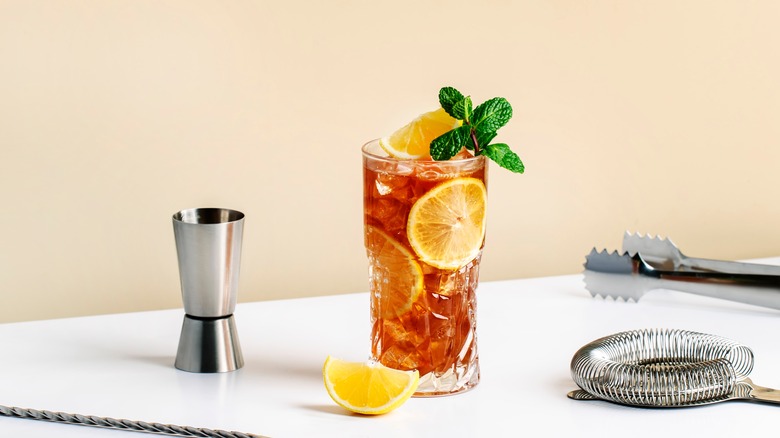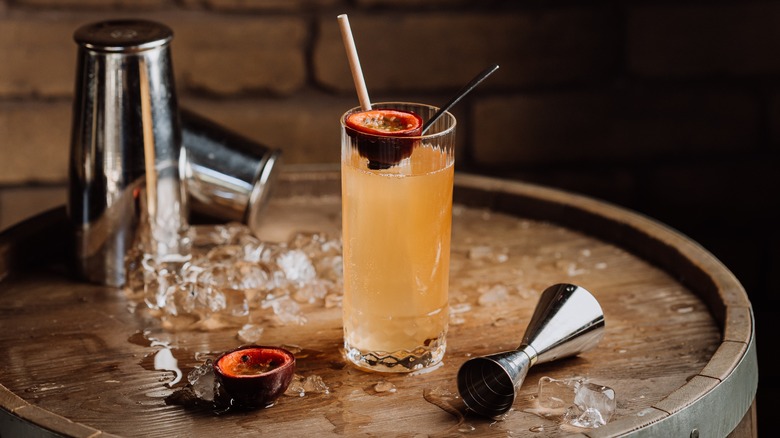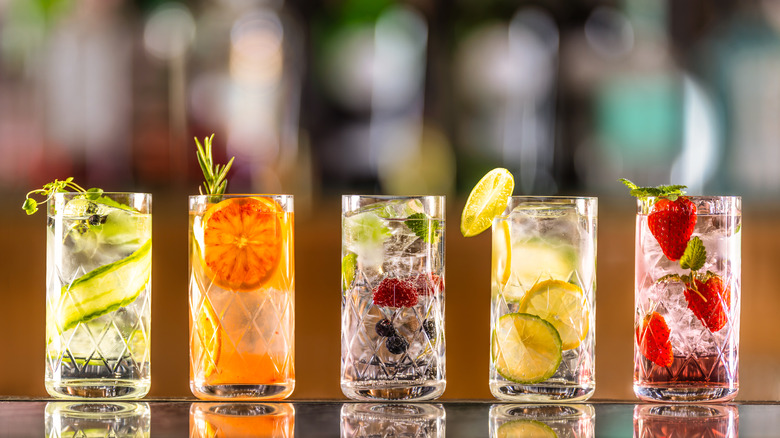When Should You Drink Your Cocktail In A Highball Glass?
In addition to pouring out various booze, assembling a cocktail involves many considerations. There's the method of mixing, garnishes, and — no less importantly — the serving vessel itself. Presentation is a large part of cocktail enjoyment, so it's wise to stock up on cocktail glasses and know the right way to use them. And one of the most essential vessels you'll want to keep on hand is the highball glass.
This container is tall and narrow, reminiscent in shape of a candle. Traditionally, it holds around 10 ounces of liquid, although modern manufacturers craft in a large range. Its capacity is just a bit smaller than the Collins glass, and bigger than the Delmonico, with which it's frequently confused. What's most important is its narrow, slender shape.
The highball is the vessel of choice for delicious fizzy drinks, comprised of a spirit topped with a carbonated beverage of choice. Some ice goes into the glass, as well as a garnish, which is oftentimes a slice of citrus. As a result, this serving vessel is the perfect choice for refreshing yet casual drinks. And its size enables incredible creativity, too.
Employ a highball glass for a liquor-based carbonated drink
The parameters of highball glasses enable tall, bubbly cocktails to shine. As opposed to a wide-rimmed martini or coupe, there's less surface area, aiding in keeping the fizz going strong. Meanwhile, the contained volume is precisely spaced; you can fit exactly all of your cocktail components plus ice. As a result, it's easy to construct the entire cocktail in the serving vessel, no shaker required.
Many of the most popular cocktails fall into such a formula: gin and tonic, rum and coke, and of course, the beloved whiskey highball. Traditionally the highball doesn't include a fruit addition — that's what delineates it to a Collins or Rickey, which come in a larger glass. However, such customs are eroding, with today's recipes integrating creative syrups, liqueurs, bitters and more, not to mention classic combinations of soda and spirit being exchanged for more unique highball takes — like the retro 7 And 7 swap for a rum and coke.
These expansive options yield a treasure trove of drinks fit for enjoyment in the vessel, covering a spectrum of flavors. From a Dark'n Stormy, to a Paloma or an Americano, the highball glass is a go-to across many mixology scenes.
The highball glass itself plays an important role in cocktail creation
Since highball drinks are assembled in the glass, the parameters of this serving vessel are important to consider. A well built rendition of the drink should be contained in an 8 to 10-ounce glass, constructed with a 2-ounce pour of a base spirit. The precise ratio varies; but the range is from equal parts to as much as three times the amount of carbonated water to liquor. Make sure to measure precisely, especially in a large vessel. Otherwise, it's easy to craft something that's either overly strong or too watery.
As with other cocktails, cooling the mixture is key. Scoopfuls of preferably clear ice should fill the serving vessel, plus the glass and liquor should be chilled beforehand. Keeping temperatures low will not only enhance the drink's refreshing nature, but also aid in maintaining strong carbonation. Not to mention the ice in the mix will melt slower, too, keeping ratios in order. So to lend your highball a pleasant crispness, you'll want to select a well-sized glass that enables cold containment.
Unfortunately, many glass models sold in the store are often too large, going all the way up 20 ounces. Although marketed as a highball glass, such a vessel is actually a hindrance to crafting the perfect carbonated sipper. So it's not just about the vessel type, but its specific volume, too.


